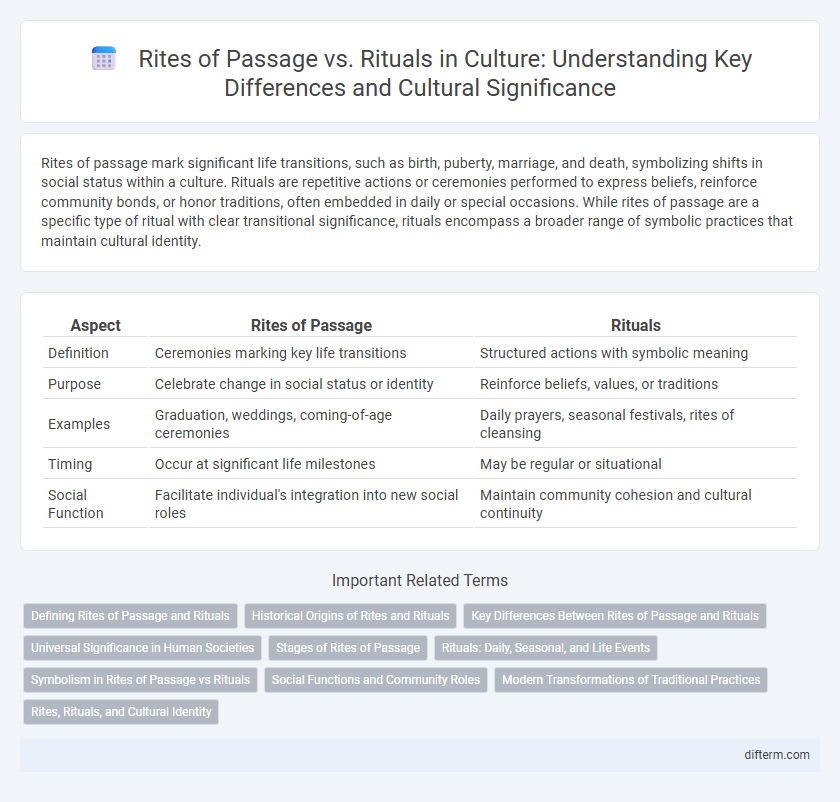Rites of passage mark significant life transitions, such as birth, puberty, marriage, and death, symbolizing shifts in social status within a culture. Rituals are repetitive actions or ceremonies performed to express beliefs, reinforce community bonds, or honor traditions, often embedded in daily or special occasions. While rites of passage are a specific type of ritual with clear transitional significance, rituals encompass a broader range of symbolic practices that maintain cultural identity.
Table of Comparison
| Aspect | Rites of Passage | Rituals |
|---|---|---|
| Definition | Ceremonies marking key life transitions | Structured actions with symbolic meaning |
| Purpose | Celebrate change in social status or identity | Reinforce beliefs, values, or traditions |
| Examples | Graduation, weddings, coming-of-age ceremonies | Daily prayers, seasonal festivals, rites of cleansing |
| Timing | Occur at significant life milestones | May be regular or situational |
| Social Function | Facilitate individual's integration into new social roles | Maintain community cohesion and cultural continuity |
Defining Rites of Passage and Rituals
Rites of passage are culturally significant ceremonies marking important life transitions such as birth, puberty, marriage, and death, symbolizing personal and social transformation. Rituals consist of prescribed actions and symbolic gestures performed repeatedly within a cultural or religious context to express beliefs, reinforce community bonds, or achieve specific outcomes. While rites of passage focus on transitional milestones, rituals broadly encompass a variety of structured practices that maintain social order and cultural identity.
Historical Origins of Rites and Rituals
Rites of passage originated from ancient societies as structured ceremonies marking significant life transitions such as birth, puberty, marriage, and death, deeply embedded in cultural identity and social cohesion. Rituals, often more repetitive and symbolic, evolved across diverse civilizations to reinforce communal values and spiritual beliefs through prescribed actions and ceremonies. Both rites and rituals share roots in early human history, reflecting fundamental human needs for meaning, order, and connection within communities.
Key Differences Between Rites of Passage and Rituals
Rites of passage are culturally significant ceremonies marking important life transitions, such as birth, adulthood, marriage, or death, and often involve clearly defined stages of separation, liminality, and incorporation. Rituals, by contrast, encompass a broader range of repetitive, symbolic actions performed by individuals or groups to express beliefs, reinforce social norms, or invoke spiritual power, without necessarily signifying a life transition. Key differences include the functional purpose, with rites of passage focused on transformation and identity change, while rituals maintain or restore social order and cohesion through established symbolic acts.
Universal Significance in Human Societies
Rites of passage and rituals hold universal significance across human societies by marking critical transitions in an individual's life, such as birth, coming of age, marriage, and death. These cultural practices serve to strengthen social bonds, convey shared values, and facilitate individual identity within a community. Anthropological studies highlight their role in maintaining societal cohesion and continuity through symbolically rich ceremonies.
Stages of Rites of Passage
Rites of passage typically involve three key stages: separation, transition (or liminality), and incorporation, each marking a critical transformation in an individual's social status. The separation stage involves detaching from the previous identity, followed by the liminal phase characterized by ambiguity and transformation, and finally incorporation where the individual is reintegrated into society with a new role. Rituals, while sometimes part of rites of passage, do not always follow this structured sequence and can occur independently as symbolic acts without transformative social recognition.
Rituals: Daily, Seasonal, and Life Events
Rituals encompass daily practices like prayer or meditation, seasonal ceremonies linked to agricultural cycles or solstices, and significant life event celebrations such as weddings, births, and funerals. These actions reinforce cultural identity, foster community cohesion, and provide structure to personal and collective experiences. Understanding the role of rituals reveals their importance in maintaining social continuity and transmitting cultural values across generations.
Symbolism in Rites of Passage vs Rituals
Symbolism in rites of passage often marks significant life transitions, using metaphors and symbols to represent transformation and new social status. Rituals utilize symbolic actions as structured practices that reinforce community beliefs and cultural continuity, frequently involving repeated gestures or ceremonies. Both rely on symbolic meaning but rites of passage emphasize personal change, while rituals emphasize collective identity and tradition.
Social Functions and Community Roles
Rites of passage mark significant life transitions, reinforcing social roles and community membership through structured ceremonies. Rituals serve to maintain social cohesion by expressing shared values and fostering group identity. Both play essential roles in sustaining cultural continuity and social order within communities.
Modern Transformations of Traditional Practices
Modern transformations of traditional rites of passage reveal a shift towards personalized and inclusive rituals that reflect contemporary social values and identities. Digital technology and globalization enable new forms of ceremonies, blending cultural heritage with innovative expressions to create meaningful experiences in diverse communities. These evolving practices highlight the dynamic interplay between tradition and modernity in cultural continuity and adaptation.
Rites, Rituals, and Cultural Identity
Rites of passage serve as significant ceremonies that mark important transitions in an individual's life, such as birth, puberty, marriage, and death, reinforcing cultural values and social roles. Rituals, encompassing repetitive and symbolic actions, function to strengthen community bonds and maintain continuity within a culture. Together, rites and rituals play a crucial role in shaping and expressing cultural identity, preserving traditions, and fostering a sense of belonging among members of a society.
rites of passage vs rituals Infographic

 difterm.com
difterm.com